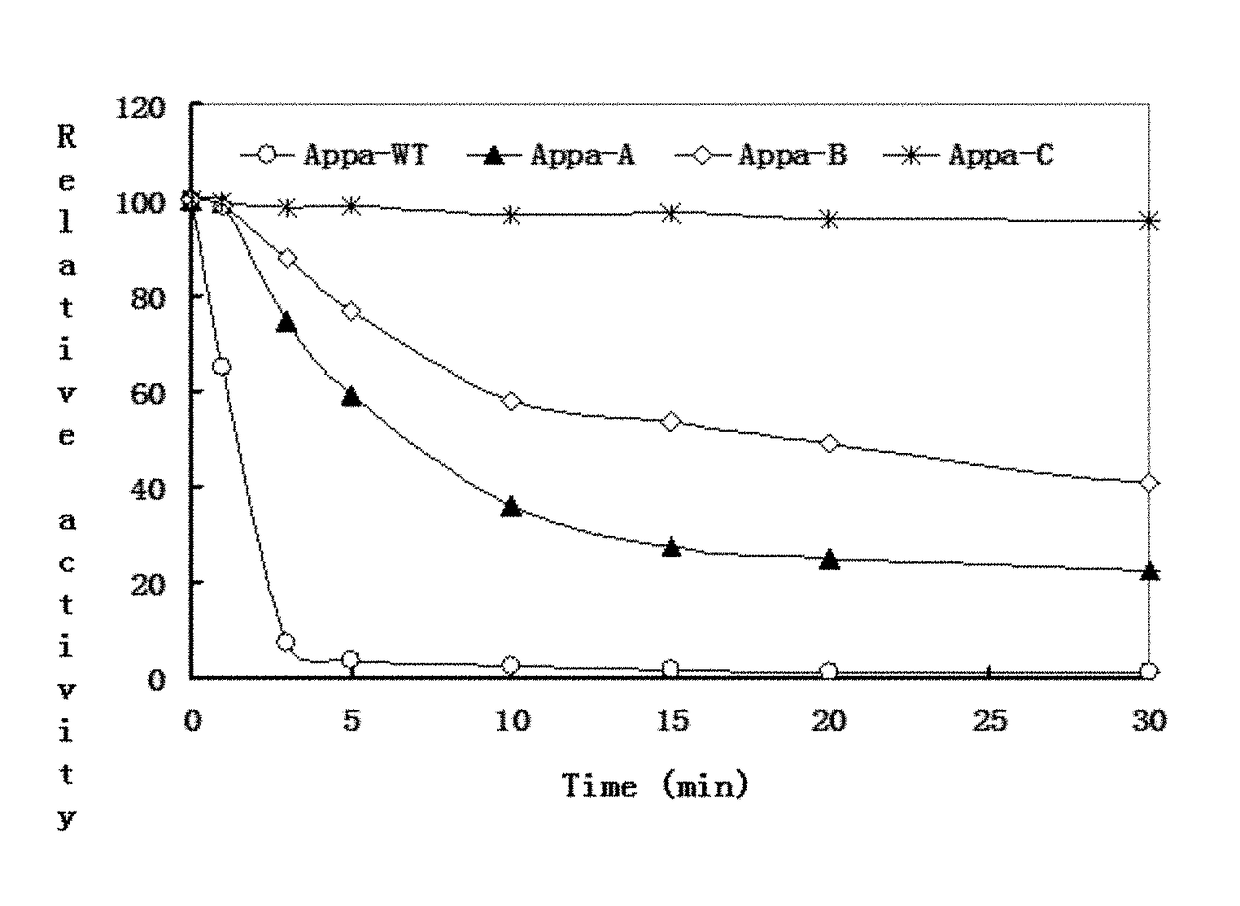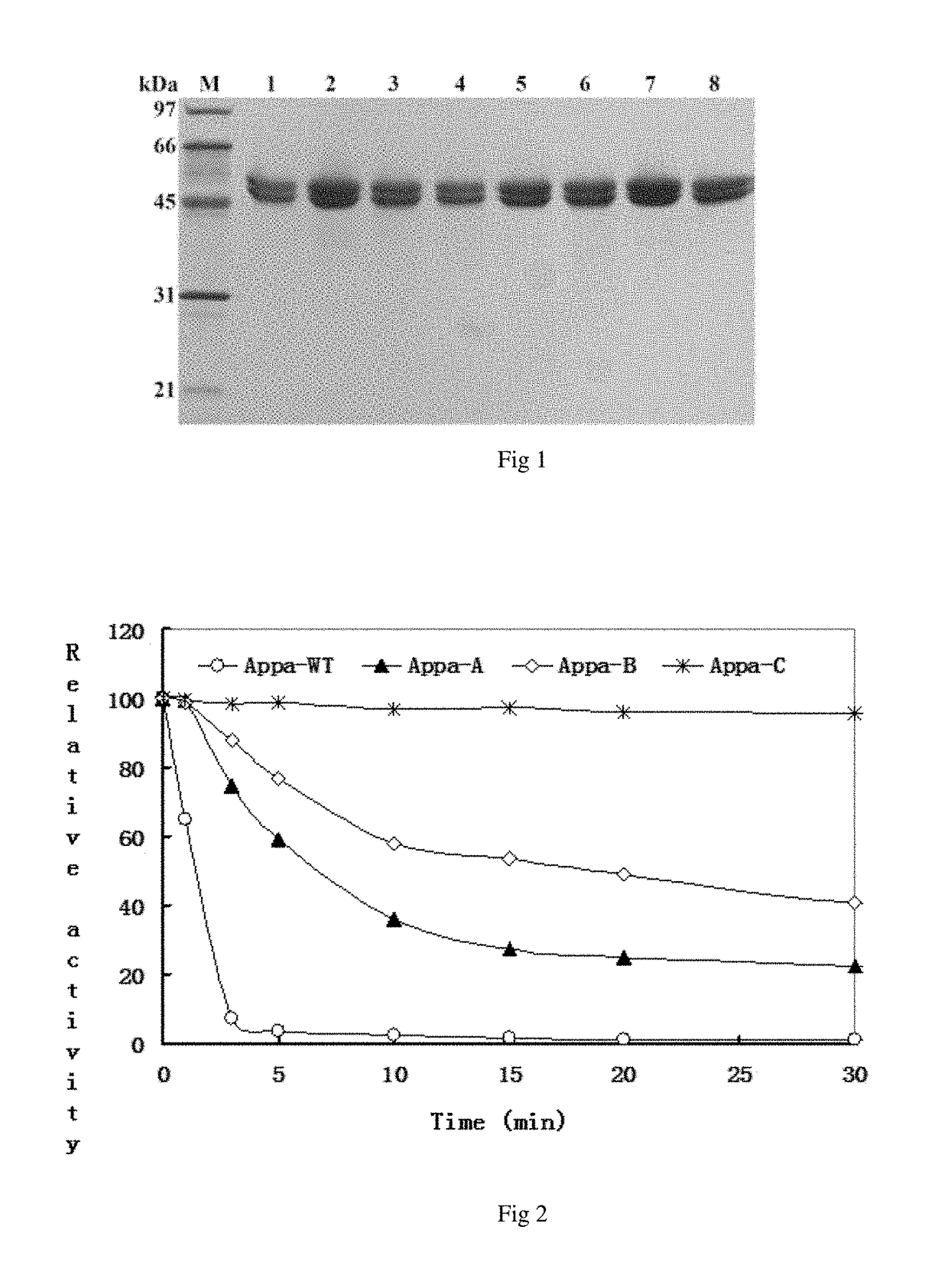Method for producing a phytase variant with improved thermal stability, and a phytase variant and the use thereof
a technology of thermal stability and phytase, which is applied in the field of gene engineering, can solve the problems of inorganic phosphorus, high cost, and low utilization efficiency of phosphorus, and achieve the effects of improving thermostability, improving enzymic characteristics, and improving enzymic characteristics
- Summary
- Abstract
- Description
- Claims
- Application Information
AI Technical Summary
Benefits of technology
Problems solved by technology
Method used
Image
Examples
embodiment
Example 1, Designing the Introduction of the Proline to Obtain the Phytase Variants, Constructing the Expression Vector of the Phytase Variant Gene and Expressing in Pichia pastoris
[0045](1) Rational Design the Phytase
[0046]A three-dimensional model is researched based on the three-dimensional structure of phytase APPA of E. coli recorded in Protein Databank (http: / / www.rcsb.org / pdb / ). B-factor of the protein is an important indicator of the stability of it specific amino acid, which the higher B-factor value of the amino acid, and the lower structure stability of said amino acid or the section containing it. Finally, the sites of the phytase APPA with higher flexibility are determined as S80, S151, T161, N176, S187 and A380 by calculating and ranking the B-Factor value of each amino acid, optimizing based on the research on the amino acid and the section containing it with the higher B-Factor value in connection with the assay results. Then, the prolines are introduced at these si...
example 2
, Preparing the Phytase Variants and Measuring their Activity
[0051](1) Concentrate
[0052]3 L of supernatant is collected by centrifugal the BMMY medium after induced the expression of the phytase at 4° C. at the rate of 10,000 rpm for 10 mm, concentrated to 250 mL, and further concentrated in a Filtron ultrafiltration unit with 5 kDa cutoff filters to 50 mL;
[0053](2) Ammonium Sulfate Fractionation Precipitation
[0054]The concentrated crude phytase is precipitated with the concentration of 40-75% ammonium sulfate, and the very low phytase activity is remained in the supernatant at 75% saturation. The precipitant collected by centrifugal is dissolved in 5 mL of Tris-HCl buffer solution with pH 8.0, and dialyzed, followed by concentrating with PEG 8000.
[0055](3) Anion Exchange Chromatography
[0056]The dialyzed phytase is purified with HiTrap Q Sepharose XL, anion exchange chromatography column, equilibrated with 20 mmol / L Tris-HCl solution (pH 8.0), eluted with 20 mmol / L Tris-HCl solution...
example 3
, Optimal Temperature and Thermostability of the Phytase Variants
[0059](1) Temperature Characteristic
[0060]The activity of the interest dilution of the phytase variants purified in the Example 2 is measured in 0.25 mol / L sodium acetate buffer (pH 5.5) from 30° C. to 90° C., followed by calculating the specific activity as the average of three measurements repeated at each temperature, so as to determine the optimal temperature of said phytase, as list in the table 1 showing the mean of the specific activity at each temperature.
[0061]
TABLE 1Reacting temperature ( 0-100 meaned in relative activity and Phytase100 stand for the optimum temperature of the variant)Variants30° C.40° C.50° C.60° C.70° C.75° C.80° C.85° C.90° C.Appa-WT20416810039181020Appa-A20.734.553.176.510088.559.64.90Appa-B21.842.363.78895.110066.77.60.9Appa-C14.527.45071.191.098.710080.245.3
[0062]Wherein, specific activity is remarked as 0 to 100, and the temperature with 100 of the specific activity is the optimal temp...
PUM
| Property | Measurement | Unit |
|---|---|---|
| temperature | aaaaa | aaaaa |
| temperature | aaaaa | aaaaa |
| temperature | aaaaa | aaaaa |
Abstract
Description
Claims
Application Information
 Login to View More
Login to View More - R&D
- Intellectual Property
- Life Sciences
- Materials
- Tech Scout
- Unparalleled Data Quality
- Higher Quality Content
- 60% Fewer Hallucinations
Browse by: Latest US Patents, China's latest patents, Technical Efficacy Thesaurus, Application Domain, Technology Topic, Popular Technical Reports.
© 2025 PatSnap. All rights reserved.Legal|Privacy policy|Modern Slavery Act Transparency Statement|Sitemap|About US| Contact US: help@patsnap.com


